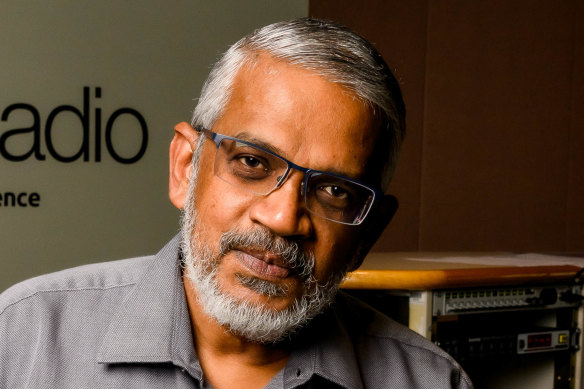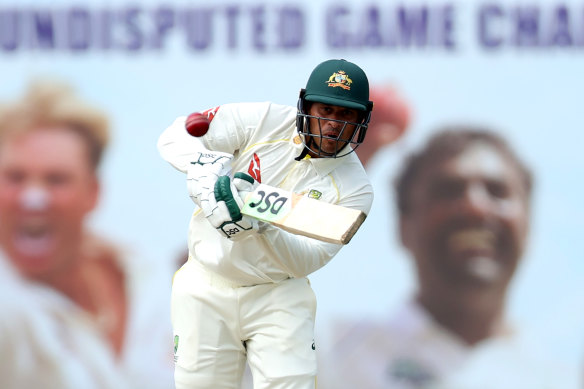Kulasegaram Sanchayan is co-host, alongside Preeti Jabbal, of SBS’ Colours of Cricket podcast, which explores South Asian perspectives on cricket in Australia and the sport’s role in bringing communities together and breaking down barriers.
Take me back to the birth of Colours of Cricket.
It was like tea brewing – it started slowly, then it grew and grew and grew and grew. The idea was floated of doing something with all the South Asian language groups, and then they said, cricket is your common theme, so why don’t you guys get together and do something with cricket. Then a few people from different language groups got together, explored the idea, and it just grew. It probably took about six to eight months from the initial idea.
Kulasegaram Sanchayan is co-host alongside Preeti Jabbal of SBS’ Colours of Cricket podcast.Credit:Ashley Mar
How many language groups are involved in the podcast?
Nine – Hindi, Gujarati, Punjabi, Tamil, Malayalam, Urdu, Nepali, Bangla and Sinhala.
As a lifelong cricket lover, it must be lovely to do a project focused on your passion like this.
The theme is: we don’t like cricket, we love it. I didn’t play cricket – I played cricket in the streets, but never played professionally or in any meaningful capacity – but we would talk statistics, we would talk about how someone could’ve bowled a ball differently, as if we were the experts. We grew with cricket, we lived cricket.
In Australia, has it been strange to be a cricket fan of South Asian descent when cricket in Australia has, for most of its history, been an incredibly “white” sport – at least at the top level?
Yeah, so that’s what we explored, to see why that is. There were a couple of reasons we explored: whether there was bias, unconscious bias that the selectors had; or is it the sticky word racism? We also found that South Asians, because they are first or second generation migrants, their focus, and their parents’ focus, was on career and education for the children.
Because cricket is a full-time thing: you have to spend a lot of weekends in the fields, and it conflicts with their study time. That’s one of the reasons – not the only reason, but one of them – that you find lots of South Asian names in grassroots cricket, but as you progress the names drop off. But the thinking is changing because the South Asian population has been here for 50 years now or maybe more, so they’re also becoming affluent, and the focus is shifting slightly. So in the future we may see more South Asian players wearing baggy green than ever before.
Usman Khawaja has appeared as a guest on the Colours of Cricket podcast.Credit:Getty Images
Which would be wonderful – as an Australian cricket fan, that’s a resource I’d love to see tapped.
One more thing we found, also: in England it was a class issue. Only the elites play cricket. But in Australia, it’s played by everyone, even at the lower economic strata. And you find that in most South Asian countries, cricket is played in the streets. So there was kind of a mirroring of social attitudes when it came to grassroots cricket. But also in South Asian countries you find that selectors prefer certain classes of people in the teams. That’s another thing we found.
On the podcast you managed to get an amazing guest line-up: people like Usman Khawaja, Sunil Gavaskar, Kapil Dev, Tillakaratne Dilshan, Ijaz Ahmed. How did you attract such high-calibre guests?
When we pitched the idea of different South Asian languages coming together and exploring this in Australia, it was an easy sell. Actually, we had more talent than we could put in eight episodes of the podcast. They were more than willing to come. And we had a good resource: Patrick Skene, who writes for The Sydney Morning Herald – he is a very quote-unquote “influential” person. He has his personal charm, so he helped as well in finding a lot of the talent. He also worked as an advisor on the podcast because he had seen the Australian cricket landscape change over time.
You must’ve seen the cricket landscape change a lot yourself in your time in Australia.
Yep. Even the format has changed a lot.
What do you think of the different formats? Are you a fan of Twenty20?
Well, if you want to keep the game alive … no one is interested in watching a five-day Test series if that is the only format we’re going to play. People have the appetite now because everything is changing rapidly and people want instant gratification. Test series have a place, but it’s not the biggest focus of the game anymore. Incidentally, we landed on eight episodes for the podcast because Australian cricket until the ’70s had eight balls in an over.
Yes that’s right! So the game has always been changing and evolving. You’ve lived in Australia for 25 years: are you now a fully-fledged fan of the Australian cricket team?
When I’m in Australia, I cheer for the Australian team, even when it plays against India or Sri Lanka or any South Asian team. But there are people who fix their allegiance in our community, and that’s perfectly acceptable. And in the same household you’ll find parents cheering for their homeland and their children cheering for Australia.
When India and Sri Lanka come to tour here, you can see the level of support in the crowds, and I often think those fans put us to shame, teaching us how you support a cricket team.
We have an episode coming on that, on the fans and how they’ve changed the atmosphere, with colours and music and, if they’re allowed to, the food they bring to the cricket field.
Colours of Cricket is available at sbs.com.au/coloursofcricket, in the SBS Radio app, Spotify, Apple Podcasts, Google Podcasts and other podcast apps.
Find out the next TV, streaming series and movies to add to your must-sees. Get The Watchlist delivered every Thursday.
Most Viewed in Culture
From our partners
Source: Read Full Article



